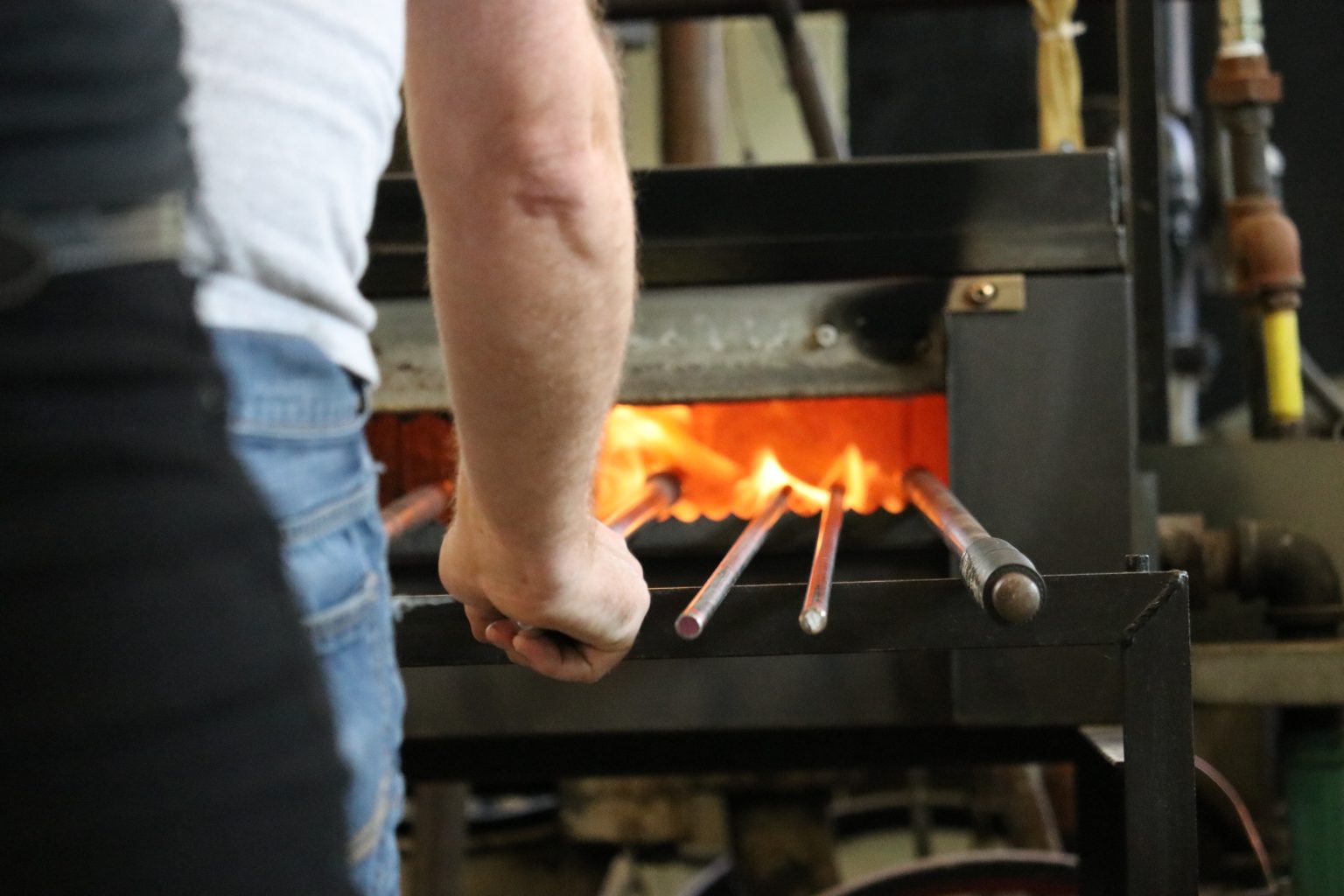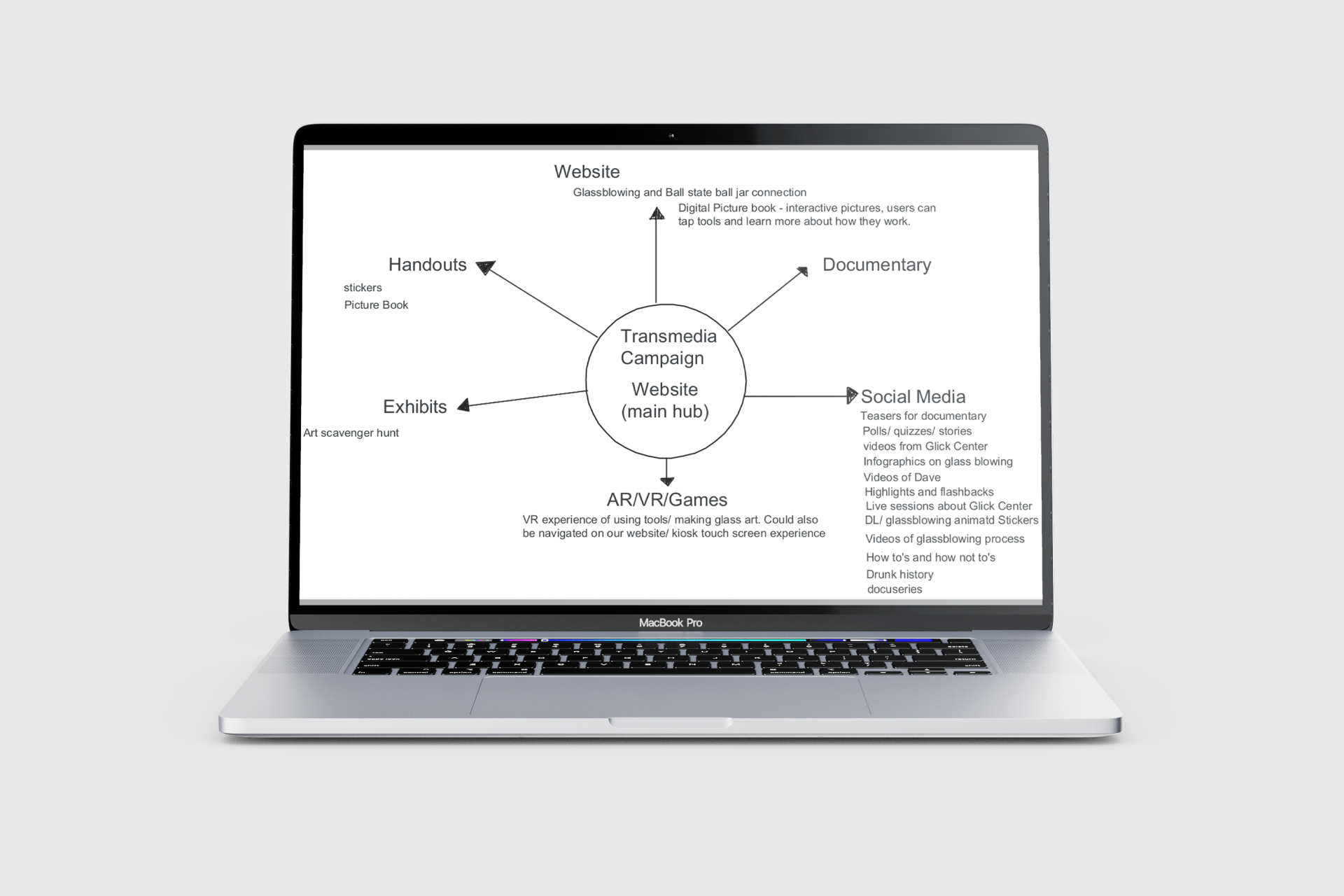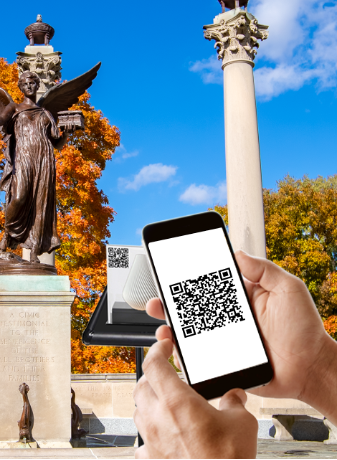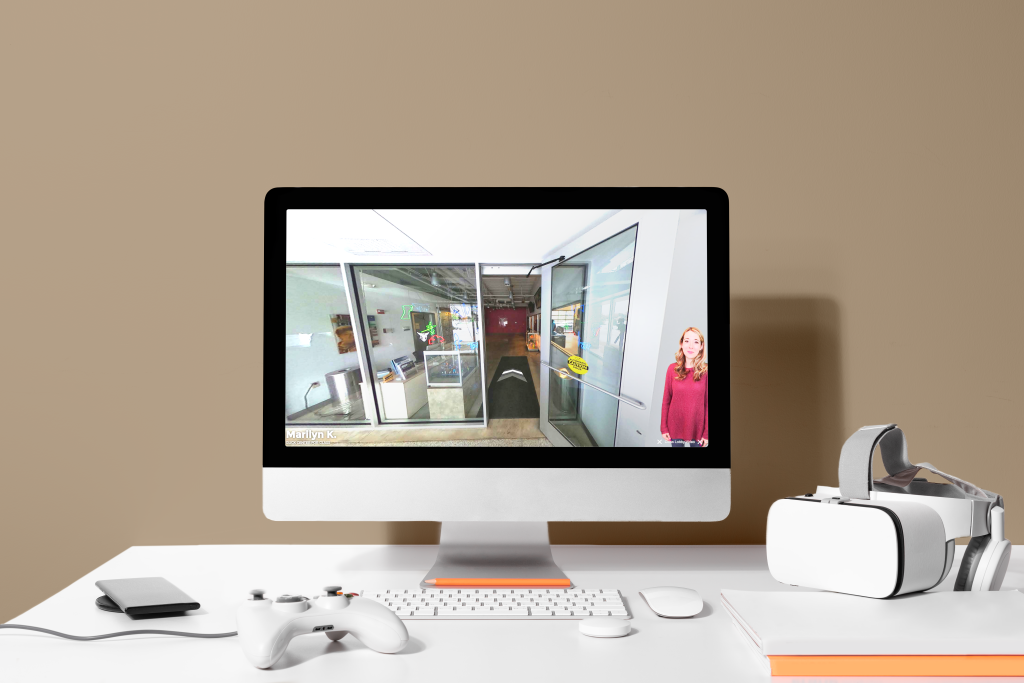Building a Thorough Story World

OVERVIEW
The David Letterman Learning Experience (DLLE) is a student-led, interdisciplinary creative project within the Emerging Media Design and Development graduate program that combines storytelling, technology, and art to give students project-based, hands-on experience with community partners.
In the fall of 2021, Letterman approached Ball State with a collaboration opportunity. For several years, Letterman had been constructing a phone case out of colorful duct tape for his iPhone 7, and during the COVID-19 lockdowns, he came across the Netflix series "Blown Away," a glass blowing competition show featuring glass artists. His interest in glass blowing sparked an idea to commemorate his phone case in glass. Knowing that Ball State is the home to the Marilyn K. Glick Center for Glass, Letterman requested a student-created documentary on the creation of his phone-case-inspired artwork. The Clear Reception project was born through his request.













IDEATION
PROBLEM SPACE:
After retiring from his show in 2015, Letterman and his team donated hundreds of artifacts to Ball State for their use in the The David Letterman Learning Experience. A Letterman-focused exhibit already exists on campus. The involved teams needed to figure out a way to draw attention to this exhibit, create a documentary about his art piece, and celebrate the Marilyn K. Glick Center's 10-year anniversary on campus in one fell swoop.
CHALLENGE
How might we develop a leverage the rich storytelling potential of the storyworld presented to us to document the artistic process of glassblowing and promote the 10th anniversary of the Glick Center?
SOLUTION:
As a solution, DLLE students developed the Clear Reception transmedia storytelling campaign. Transmedia storytelling tells a story across multiple platforms, and its purpose in this project is to increase viewership, celebrate the Glick Center, and increase community engagement with the story.
METHODS, RESEARCH & ANALYSIS
The primary method we used to create a solution for this project was similar to the Design Sprint method. However, with the complexity of our project, it was mapped over several weeks rather than days. During this time, we mapped our challenges, came up with individual solutions, brainstormed as a whole group, decided on our solutions, prototyped, and tested solutions on users.
- Our first step in this process was to develop our team and assign roles to each individual based on their skillset.
- Then, we defined our problem.
- We then used brainstorming as a group using Google Jamboard to create ideas.
- We used rapid prototyping in various platforms (Jamboard, Figma, Gloomaps, etc.)
- We performed empathy research and testing on users for feedback.
- And most importantly, sometimes we had to scrap and refine our ideas.







Solutions
The DLLE team developed a transmedia storytelling campaign surrounding the Clear Reception documentary. The campaign including a social media campaign, a website, a virtual reality tour, and a campus-wide scavenger hunt.

The DLLE social media campaign provides a platform for storytelling to increase viewership for the David Letterman Learning Experience, Digital Media Department students, and the Marilyn K. Glick Center Students. It also draws attention to other pieces of transmedia campaign, like the virtual reality tour and augmented reality scavenger hunt. The social media campaign documents the process Ball State students followed to create each element of this project through photos, videos, and interactive graphics. Our social platforms also showcase all of the students’ hard work, inspirations, and career goals following graduation from Ball State. Social media platforms include Instagram, Twitter, Facebook, and TikTok.
Our primary research question for social media is: how can we successfully promote the documentary, the David Letterman Learning Experience, and the Center for Emerging Media Design and Development on social media?
For the first time in the four years of the David Letterman Learning Experiences’ existence, the DLLE students were granted permission to share the work of past and present cohorts with the public. The DLLE website serves as a hub for all projects developed by DLLE students. It houses or links out to all aspects of the transmedia campaign, showcases each of the previous cohorts, and summarizes their projects. While developing a website is a simple, straightforward solution for the DLLE, it fulfills a crucial function. It ties each aspect of the DLLE transmedia campaign together, links to published research by DLLE students, advertises the Emerging Media Design and Development graduate program, and allows users to learn more about DLLE projects.
The Glick Center houses Ball State’s glass art program, one of the county’s few glass art university programs. While the atrium of the Glick Center is accessible to the public, the building is only physically open to visitors at limited times. The building’s limited availability hinders the promotion of the glass art program and the ability to share the types of work done at the Glick Center. The research question arising from these opportunities was: How might we promote and provide accessibility for a broader audience to the Glick Center in a way that explores the space and its programs?
Research and Development: To ensure a beneficial experience, the Letterman Learning Experience team used design thinking processes to build the virtual tour. To create the interactive tour experience, we used professional virtual tour software, 3dVista. A GoPro camera allowed us to take 360-degree photos of the Glick Center and import them into the software, creating the virtual space. A user experience map was then created to identify the locations within the space that would be identified as hotspots with featured information for users. We then gathered video interviews and images of the Glick Center. These assets provided information for the hotspots within the virtual space and helped to make the tour an interactive learning experience.
Although the documentary has a handful of stories it aims to share, there is only so much a 15-minute film can cover. In addition to the excitement of Letterman’s request and involvement with the project, there are stories of learning, achievement, failure, and teamwork that will not get their time to shine in the documentary. This limitation inspired the team to create an experience that uses the unaired stories and footage associated with this project. Another point of consideration was that the other elements of the transmedia campaign are digital experiences. There is an opportunity to take a step out of the digital world and engage the greater Ball State community in a physical exhibition. Both opportunity spaces presented the question: How might we use placemaking to share the untold stories of the documentary with the Ball State community?
The Glick Center is full of storytelling opportunities. The Augmented Reality (AR) Scavenger Hunt amplifies those stories by transforming Ball State’s campus into a virtual art gallery, showcasing student artwork, building anticipation for the documentary, and encouraging audiences to learn about art created by BSU students. A simple process defines the scavenger hunt. First, participants hunt for eight display cases hidden around the Ball State campus. Next, participants scan a QR code near or on the display cases. The QR codes reveal exciting stories about the artifacts or multimedia experiences related to theClear Reception with David Letterman documentary.
Research and Development: Our team utilized user-centered design and designthinking to address our problem space and develop a scavenger hunt that will transform Ball State’s campus into an art gallery and digital storytelling experience. First, our team began planning an idealuser journey using Jamboard.We thought through how our audience will discover the event, interact with the art stations, and experience the digital content. Understanding our ideal user journey helped us keep our scope narrow, organize our goals, and think through the details of user accessibility. After the user journey, we created a lo-fi prototype of the scavenger hunt.The lo-fi prototype adds a visual aspect to the user journey, allowing our team to be on the same page regarding the design, layout, and implementation of this event. Our team conducted user testing via asurveyto test the lo-fi prototype. We sent the survey to 30 first-year graduate students. The students provided feedback on their experiences with scavenger hunts, motivations for participating in university events, and interest in learning about art. Once we received the survey results, our team used design thinking to organize the responses into actionable next steps that will elevate our scavenger hunt. Our team began with the saturate and group method. We compiled all the answers onto aGoogleJamboardand grouped them on a matrix of new ideas, current ideas, actionable, and unreasonable. We then took all the ideas that fell into the corner of new ideas and actionable and put them on Post-It notes. We were able to connect the new ideas to a specific scavenger hunt stop for its artifact, web content, or general stop experience. With the testing and design thinking complete, we could devise a more concrete plan for each scavenger hunt stop and begin designing the web pages. We have completed the two stops, created QR codes for each stop, organized all the content we have into folders, selected our artifacts for each stop, and compiled a list of the artifacts and content still needed.Here is our up-to-date planning document.
PROTOTYPES










Documentary
The "Clear Reception with David Letterman" documentary aired on Ball State University's campus on May 1, 2023. The project was developed by Ball State students in the Department of Media, Center for Emerging Media Design & Development, and Schools of Art and Music. In the film, artists from the Marilyn K. Glick Center for Glass, teach Letterman about the evolution of glass, as well as discuss Ball State's rich history in glass-making. Students from the Ball State School of Music students composed and performed an original score for the film. On the day of the premiere, a team of students in the Center for Emerging Media Design & Development presented the transmedia campaign discussed above in the Emens Auditorium lobby before and after the film showing.
Considerations
This project began in 2021 with and ended in 2023 with a second team of students. All project began with one group of students and were taken over to be finished by a second group.


Designing a Strategic 3D VR Museum Experience

